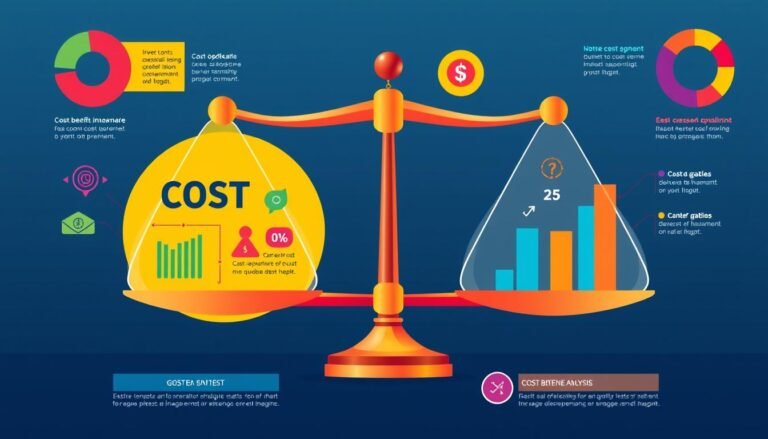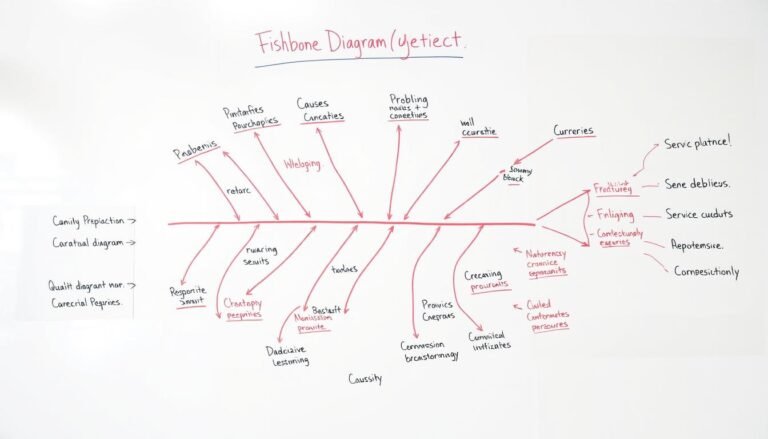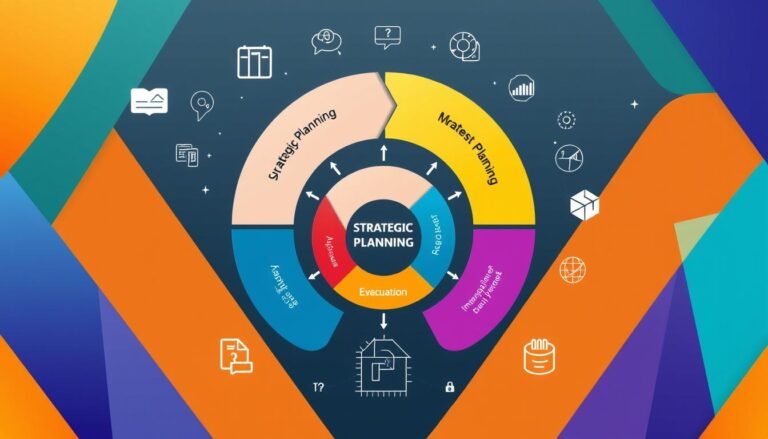Understanding Diseconomies of Scale Effects
Have you ever wondered why some companies see costs go up even as they make more? This mystery often points to diseconomies of scale. This is when making more doesn’t mean costs go down. Instead, it can make things more expensive.
Unlike the idea that bigger means cheaper, diseconomies of scale show the hurdles of growth. As companies get bigger, they might face problems that make things pricier. These issues come from inside the company and outside forces. Exploring these challenges sheds light on how businesses can grow sustainably.
Key Takeaways
- Diseconomies of scale indicate increasing average costs with higher production.
- Internal and external factors contribute to increased operational challenges.
- Complex communication structures can lead to inefficiencies in large organizations.
- Top-heavy structures may result in higher bureaucracy and management costs.
- Firms must adapt strategies to mitigate the adverse effects of scale.
- Understanding diseconomies is essential for sustainable business growth.
What Are Diseconomies of Scale?
Diseconomies of scale are important in understanding how businesses manage costs and efficiency. They happen when making more products costs more per item. This is because growing a business can bring more problems that make costs go up. Let’s look at what this means for businesses.
Definition and Key Takeaways
Here are the main points about diseconomies of scale:
- Definition: Making more products can make costs per item go up, hurting profits.
- Internal Factors: Problems in making products and managing the company can make costs higher.
- External Constraints: Issues outside the company can also make costs go up.
Differences from Economies of Scale
It’s important to know the difference between economies and diseconomies of scale. Economies of scale mean making more products costs less per item. Diseconomies of scale mean costs start to go up after a certain point. Here are the main differences:
| Aspect | Economies of Scale | Diseconomies of Scale |
|---|---|---|
| Cost Dynamics | Declining average costs with increased output | Rising average costs beyond a certain output level |
| Production Efficiency | Higher efficiency and profit survival | Reduced efficiency, potential loss of profitability |
| Management Focus | Streamlined operations for growth | Need for strategic management to prevent overextension |
Knowing these differences helps businesses grow without losing money.
Causes of Diseconomies of Scale
Understanding the causes of diseconomies of scale is key for businesses wanting to grow well. Many factors make costs go up as companies get bigger. This can hurt their efficiency and profits. These factors are both inside and outside the company, each with its own problems.
Internal Factors Affecting Costs
Internal diseconomies of scale come from managing a bigger organization. These issues include:
- Coordination and Communication Challenges: Growth can make production costs go up by 8-12% when the number of departments goes up by 20%.
- Bureaucracy and Organizational Complexity: Companies with more than six management layers might see a 15-20% jump in admin costs. This affects total spending.
- Inefficiencies in Resource Allocation: Big firms often spend about 10-15% on projects that don’t do well. This cuts down on efficiency by 5-8%.
- Employee Morale and Industrial Relations Issues: With more employees, satisfaction can drop by 25-30%. This leads to a 10-15% drop in productivity because people are less happy at work.
External Factors Impacting Production
External factors can really affect how much you can produce and costs. It’s important to know how these things work together in the market:
- Increased Transportation and Distribution Costs: Growing to serve more areas can increase transport costs by 20-25% for every 15% bigger area you cover.
- Difficulty in Innovation: Big companies are 30-35% less likely to bring out new products because of too much red tape, which can stop growth.
- Quality Control Challenges: Keeping quality up can cost 10-15% more for every 25% increase in how much you make, as it gets harder to keep things consistent.
- Government Regulations: Following rules can cost 7-10% more each year for firms that get too big, adding to expenses.
These internal and external factors can make it hard to keep up production and push companies into diseconomies of scale. It’s important to tackle these issues early to keep operations running smoothly.
| Internal Factors | Impact on Costs |
|---|---|
| Coordination and Communication Challenges | 8-12% increase in per-unit production costs |
| Bureaucracy and Organizational Complexity | 15-20% increase in administrative costs |
| Inefficiencies in Resource Allocation | 5-8% decrease in operational efficiency |
| Employee Morale Issues | 10-15% decrease in productivity |
Types of Diseconomies of Scale
Understanding the types of diseconomies of scale is key for businesses. These challenges can be split into internal and external factors. Each type brings its own set of problems. This part looks at both organizational and technical diseconomies.
Internal Diseconomies of Scale
Internal diseconomies come from within the company. When companies grow, they might face:
- Technical Issues: Production limits can cause inefficiencies. Trying to make more can overload current systems.
- Management Challenges: A bigger team means more people to manage. This can slow down decisions and increase costs.
External Diseconomies of Scale
External diseconomies come from things outside the company’s control. These include:
- Resource Scarcity: Using too many shared resources can make things more expensive.
- Market Conditions: Changes in the cost and availability of important inputs can raise production costs a lot.
Organizational vs. Technical Diseconomies
It’s important to know the difference between organizational and technical diseconomies:
- Organizational Diseconomies: These are about communication issues and keeping employees motivated as companies get bigger.
- Technical Diseconomies: These are about physical limits in making things, like too many items in one place and poor handling of materials.
Diseconomies of Scale Examples
Businesses often face challenges as they grow. In the manufacturing world, big companies see their costs go up when they make more products. This makes it harder for them to compete.
They try to grow fast but don’t always look at their own problems. This shows the issues that come with getting bigger.
Real-World Business Scenarios
Retail chains want to grow but face big problems with managing stock and getting products to customers. These issues lead to higher costs and unhappy customers. It shows how chasing growth can lead to problems.
Industry-Specific Cases
Every industry has its own problems with growing too big. In farming, big farms spend more on resources and don’t get as much from their work. Tech companies also face issues as they try to make more products, leading to higher costs.
These examples help us see why some companies struggle to stay efficient when they grow fast.
Source Links
- Diseconomies of scale
- Diseconomies of Scale – Guide and Examples of Rising Marginal Costs
- Diseconomies of Scale: Meaning, Causes & Graph
- Diseconomies of Scale Definition: Causes and Types Explained
- Diseconomies of Scale
- Diseconomies of Scale – Economics Help
- What are some of the main reasons for diseconomies of scale?
- Diseconomies of Scale
- Economies of Scale
- Economies and Diseconomies of Scale – Explanation and Types
- Economies and Diseconomies of Scale | CFA Level 1 – AnalystPrep







